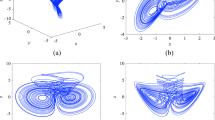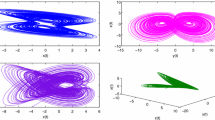Abstract
In this paper, a new four-wing attractor is reported in a fractional-order chaotic system. The chaoticness of the proposed system is investigated by obtaining Lyapunov exponents and compared with that of well-known chaotic systems in the literature. The findings reveal extremely high chaoticness of the introduced system which makes it a proper choice for encryption systems and secure communication. Furthermore, synchronization of the proposed system is studied in this paper. Sliding mode control has been used for this purpose and it is proven and illustrated that the synchronization error is asymptotically stable by employing the Lyapunov stability theorem.







Similar content being viewed by others
Availability of data and material
Not applicable to this article as no datasets were generated or analysed during the current study.
Code availability
Codes have been written in MATLAB and are available on reasonable request.
References
Cao J, Chen Y, Wang Y, Cheng G, Barrière T (2020) Shifted Legendre polynomials algorithm used for the dynamic analysis of PMMA viscoelastic beam with an improved fractional model. Chaos Solitons Fract 141:110342
Long Y, Xu B, Chen D, Ye W (2018) Dynamic characteristics for a hydro-turbine governing system with viscoelastic materials described by fractional calculus. Appl Math Model 58:128–139
Yang XJ, Abdel-Aty M, Cattani C (2019) A new general fractional-order derivataive with Rabotnov fractional-exponential kernel applied to model the anomalous heat transfer. Therm Sci 23(3 Part A):1677–1681
Wei T, Li YS (2018) Identifying a diffusion coefficient in a time-fractional diffusion equation. Math Comput Simul 151:77–95
Wu GZ, Yu LJ, Wang YY (2020) Fractional optical solitons of the space-time fractional nonlinear Schrödinger equation. Optik 207:164405
Sene N (2020) SIR epidemic model with Mittag-Leffler fractional derivative. Chaos, Solitons Fract 137:109833
Dokuyucu MA, Dutta H (2020) A fractional order model for Ebola Virus with the new Caputo fractional derivative without singular kernel. Chaos Solitons Fract 134:109717
Rajagopal K, Hasanzadeh N, Parastesh F, Hamarash II, Jafari S, Hussain I (2020) A fractional-order model for the novel coronavirus (COVID-19) outbreak. Nonlinear Dyn 101(1):711–718
Hafezi A, Khandani K, Majd VJ (2020) Non-fragile exponential polynomial observer design for a class of nonlinear fractional-order systems with application in chaotic communication and synchronisation. Int J Syst Sci 51(8):1353–1372
Khandani K, Majd VJ, Tahmasebi M (2016) Robust stabilization of uncertain time-delay systems with fractional stochastic noise using the novel fractional stochastic sliding approach and its application to stream water quality regulation. IEEE Trans Autom Control 62(4):1742–1751
Tarasov VE, Tarasova VV (2018) Macroeconomic models with long dynamic memory: fractional calculus approach. Appl Math Comput 338:466–486
Zouad F, Kemih K, Hamiche H (2019) A new secure communication scheme using fractional order delayed chaotic system: design and electronics circuit simulation. Analog Integr Circ Sig Process 99(3):619–632
Bettayeb M, Al-Saggaf UM, Djennoune S (2018) Single channel secure communication scheme based on synchronization of fractional-order chaotic Chua’s systems. Trans Inst Meas Control 40(13):3651–3664
Danca MF, Kuznetsov N (2018) Matlab code for Lyapunov exponents of fractional-order systems. Int J Bifurc Chaos 28(05):1850067
Podlubny I (1998) Fractional differential equations: an introduction to fractional derivatives, fractional differential equations, to methods of their solution and some of their applications. Elsevier
] Li, Y., Chen, Y., & Podlubny, I. (2009) Mittag-Leffler stability of fractional order nonlinear dynamic systems. Automatica 45(8):1965–1969
Li C, Deng W (2007) Remarks on fractional derivatives. Appl Math Comput 187(2):777–784
Signing VF, Kengne J, Kana LK (2018) Dynamic analysis and multistability of a novel four-wing chaotic system with smooth piecewise quadratic nonlinearity. Chaos Solitons Fract 113:263–274
Odibat Z, Momani S, Erturk VS (2008) Generalized differential transform method: Application to differential equations of fractional order. Appl Math Comput 197(2):467–477
Deng J, Ma L (2010) Existence and uniqueness of solutions of initial value problems for nonlinear fractional differential equations. Appl Math Lett 23(6):676–680
Lakshmikantham V, Vatsala AS (2008) General uniqueness and monotone iterative technique for fractional differential equations. Appl Math Lett 21(8):828–834
ur Rehman M, Khan RA (2010) Existence and uniqueness of solutions for multi-point boundary value problems for fractional differential equations. Appl Math Lett 23(9):1038–1044
Atta AG, Moatimid GM, Youssri YH (2019) Generalized Fibonacci operational collocation approach for fractional initial value problems. Int J Appl Comput Math 5(1):1–11
Lakshmikantham V, Vatsala AS (2008) Basic theory of fractional differential equations. Nonlinear Anal Theory Methods Appl 69(8):2677–2682
Hafez RM, Youssri YH (2020) Legendre-collocation spectral solver for variable-order fractional functional differential equations. Comput Methods Differ Equ 8(1):99–110
Youssri YH, Abd-Elhameed WM, Mohamed AS, Sayed SM (2021) Generalized Lucas polynomial sequence treatment of fractional pantograph differential equation. Int J Appl Comput Math 7(2):1–16
Abd-Elhameed WM, Machado JAT, Youssri YH (2021) Hypergeometric fractional derivatives formula of shifted Chebyshev polynomials: Tau algorithm for a type of fractional delay differential equations. Int J Nonlinear Sci Numer Simul
Hafez RM, Youssri YH (2020) Shifted Jacobi collocation scheme for multidimensional time-fractional order telegraph equation. Iran J Numer Anal Optim 10(1):195–223
Qi G, Chen G, Zhang Y (2008) On a new asymmetric chaotic system. Chaos Solitons Fract 37(2):409–423
Singh JP, Roy BK (2018) A more chaotic and easily hardware implementable new 3-D chaotic system in comparison with 50 reported systems. Nonlinear Dyn 93(3):1121–1148
Rössler OE (1976) An equation for continuous chaos. Phys Lett A 57(5):397–398
Chen G, Ueta T (1999) Yet another chaotic attractor. Int J Bifurc Chaos 9(07):1465–1466
Bovy J (2004) Lyapunov exponents and strange attractors in discrete and continuous dynamical systems. Theor Phys Project Cathol Univ Leuven Flanders Belg Tech Rep 9:1–19
Li XF, Chlouverakis KE, Xu DL (2009) Nonlinear dynamics and circuit realization of a new chaotic flow: a variant of Lorenz, Chen and Lü. Nonlinear Anal Real World Appl 10(4):2357–2368
Lai Q, Huang J, Xu G (2016) Coexistence of multiple attractors in a new chaotic system. Acta Phys Pol B 47(10):2315–2323
Volos C, Akgul A, Pham VT, Stouboulos I, Kyprianidis I (2017) A simple chaotic circuit with a hyperbolic sine function and its use in a sound encryption scheme. Nonlinear Dyn 89(2):1047–1061
Vaidyanathan S, Rajagopal K (2016) Analysis, control, synchronization and LabVIEW implementation of a seven-term novel chaotic system. Int J Control Theory Appl 9(1):151–174
Mohammadzadeh A, Kumbasar T (2020) A new fractional-order general type-2 fuzzy predictive control system and its application for glucose level regulation. Appl Soft Comput 91:106241
Lin TC, Chen MC, Roopaei M (2011) Synchronization of uncertain chaotic systems based on adaptive type-2 fuzzy sliding mode control. Eng Appl Artif Intell 24(1):39–49
Mohammadzadeh A, Hashemzadeh F (2015) A new robust observer-based adaptive type-2 fuzzy control for a class of nonlinear systems. Appl Soft Comput 37:204–216
Funding
No funding information.
Author information
Authors and Affiliations
Contributions
Conceptualization: Khosro Khandani; Methodology: Mohammad Ebrahim Aghili, Khosro Khandani, Majid Parvizian; Formal analysis and investigation: Mohammad Ebrahim Aghili, Khosro Khandani; Writing - original draft preparation: Mohammad Ebrahim Aghili, Khosro Khandani; Writing - review and editing: Mohammad Ebrahim Aghili, Khosro Khandani, Majid Parvizian; Software: Mohammad Ebrahim Aghili, Majid Parvizian; Supervision: Khosro Khandani.
Corresponding author
Ethics declarations
Conflict of interest
The authors declare that they have no known competing financial interests or personal relationships that could have appeared to influence the work reported in this paper.
Rights and permissions
About this article
Cite this article
Aghili, M.E., Khandani, K. & Parvizian, M. A highly chaotic fractional-order system with a four-wing attractor and its synchronization. Int. J. Dynam. Control 10, 1199–1207 (2022). https://doi.org/10.1007/s40435-021-00877-2
Received:
Revised:
Accepted:
Published:
Issue Date:
DOI: https://doi.org/10.1007/s40435-021-00877-2




